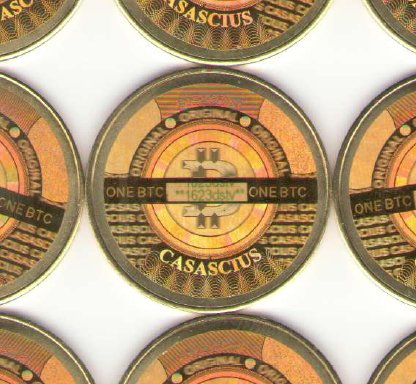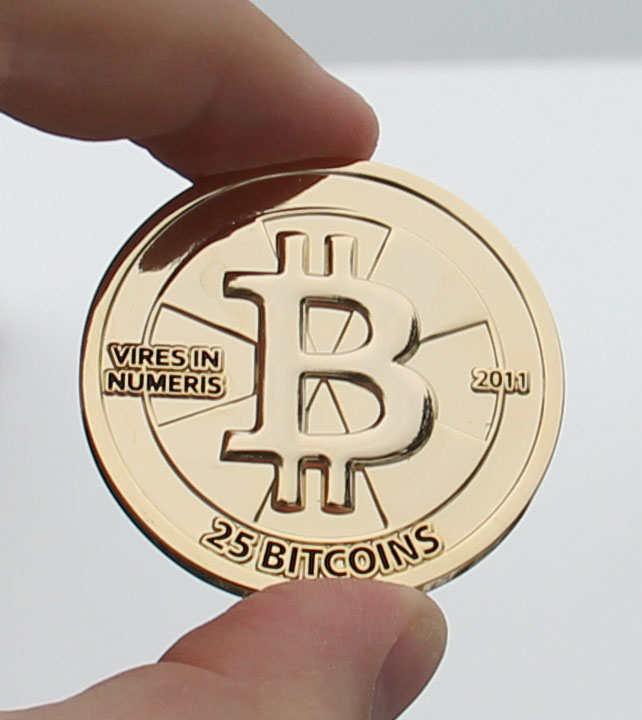Casascius physical bitcoins: Difference between revisions
m Capitalization. |
|||
| Line 6: | Line 6: | ||
The piece of paper inside each coin has a [[private key]] which forms the backing for the Bitcoin value represented by the coin. Redeeming the private key back into digital Bitcoins is currently available at [[MtGox]] (via the ''Add Funds - Redeem Private Key'' screen), as well as with a patched Bitcoin client. | The piece of paper inside each coin has a [[private key]] which forms the backing for the Bitcoin value represented by the coin. Redeeming the private key back into digital Bitcoins is currently available at [[MtGox]] (via the ''Add Funds - Redeem Private Key'' screen), as well as with a patched Bitcoin client. | ||
Casascius coins are similar to [[ | Casascius coins are similar to [[Bitbills]] in that they are an object that contains a redemption code that serves as a bearer item for digital bitcoins. | ||
==Releases of Casascius coins== | ==Releases of Casascius coins== | ||
Revision as of 19:21, 27 November 2011

Casascius physical bitcoins, also called Casascius coins, are physical metal coins created by Bitcoin user Casascius (Mike Caldwell, Sandy, Utah, USA) that contain an embedded piece of paper with digital Bitcoin value, covered by a tamper-resistant hologram. Casascius coins are available in 1 BTC and 25 BTC increments. They can be purchased at Casascius's website, https://www.casascius.com (only Bitcoin accepted), or at http://www.MemoryDealers.com (PayPal and credit cards accepted).
The coins are designed such that they could be circulated in face-to-face transactions. The first person to redeem a private key gets the value on the coin, and afterwards, the coin no longer has any Bitcoin value. However, it is difficult or impossible to read the private key on the coin without damaging or destroying the hologram, which exposes a honeycomb-like tamper evidence pattern when peeled.
The piece of paper inside each coin has a private key which forms the backing for the Bitcoin value represented by the coin. Redeeming the private key back into digital Bitcoins is currently available at MtGox (via the Add Funds - Redeem Private Key screen), as well as with a patched Bitcoin client.
Casascius coins are similar to Bitbills in that they are an object that contains a redemption code that serves as a bearer item for digital bitcoins.
Releases of Casascius coins
Original series 1 BTC coin
- 1.125 inches in diameter
- Solid brass
- Year printed on coins: 2011
- Approximately 0.24 ounces
- Eight-digit "firstbits" inkjetted onto surface of hologram sticker
- First appeared in September 2011
- Private key: 22 character string inside the coin, the 256-bit private key is SHA256(string)
- Approximate number produced: 3,500 as of November 2011
- A spelling error can be found in the small lettering of the hologram: "CASACIUS" instead of "CASASCIUS"
- Casascius has stated that no more than 11,000 may be produced
- All 11,000 Bitcoin addresses pre-generated for the series have been published as a signed text file
Second series 1 BTC coin

The hologram and the private key is different, the metal part of the coin is the same as the first series.
- 1.125 inches in diameter
- Solid brass
- Year printed on coins: 2011
- Approximately 0.24 ounces
- Denomination ("ONE BTC") appears on the hologram
- Eight-digit "firstbits" visible through a small transparent window that allows limited visibility of one side of the private key paper
- Private key: 30 character string inside the coin, the 256-private key is SHA256(string)
- First appeared in November 2011
- No spelling error in hologram
10 BTC silver round
- Announced - expected around beginning of Dec 2011
- 39mm diameter
- 1 troy ounce .999 Fine Silver
25 BTC coin

- 1.75 inches in diameter, about 3mm thick
- Gold-plated alloy
- Approximately 1.2 ounces
- Uses same holograms and private key scheme as original series 1 BTC coin
- First appeared in October 2011